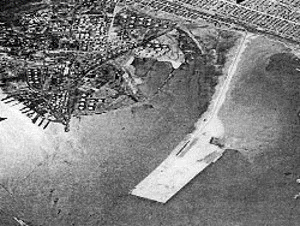History

The 430 acre site in Lower New York Harbor was created by private developers in the 1930s as a man-made peninsula off the eastern end of Bayonne, New Jersey. Initially developed for industrial use, the U.S. War Department and the Department of the Navy became interested in the site as World War II approached. There was a desperate need for an additional facility to support the Brooklyn Navy Yard and the overall war effort.
While construction of a naval supply depot in Bayonne began in March of 1941, the attack on Pearl Harbor and the United States' entrance into World War II dramatically increased the construction schedule. The United States Naval Supply Depot, Bayonne, was commissioned in 1942. A dry dock was built to accommodate Essex class aircraft carriers and the newly designed Iowa class battle ships. The Bayonne Navy Base, as it was known, became a major repair yard for wartime vessels and, during the war, usually berthed ten or more ships simultaneously. In addition, the Bayonne Navy Base was also one of the major logistical centers for Allied operations in the European Theater, with total throughput of goods in the hundreds of millions of tons.
In 1946, the U.S. Navy Diving and Salvage Training Center was relocated to Bayonne from New York, and events here would become the basis for the 2000 motion picture, Men of Honor.
Also in 1946, the Naval Supply Corps School was relocated to Bayonne, where it is estimated that one third of all Naval Supply Officers passed their training.
During the 1950s, the Bayonne Navy Base was the Department's busiest port of its kind. The base played a key role in supporting much of the rebuilding effort in Europe, as well as being instrumental in carrying out the Marshall Plan and other significant military and civilian operations during the early days of the Cold War.
In 1965, the Department of Defense decided to consolidate the Bayonne Navy Base and the Brooklyn Army Terminal. Renamed the Military Ocean Terminal – Bayonne (MOTBY), the facility became a Department of Defense East Coast Logistical Support Center. When it was re-commissioned in 1967 as a U.S. Army installation, the combined facility employed over 2,500 civilians.
During the 1970s and 1980s, MOTBY's primary mission was overseas support for all personnel stationed in the Western Hemisphere. Additionally, in 1976, the Military Sealift Command-Atlantic (MSCLANT) was relocated here.
In 1991, during the Gulf War, MOTBY was the leading military facility in support of both Operation Desert Shield and Operation Desert Storm. In the biggest test of the military's logistical support system since World War II, MOTBY moved more goods than any other installation and won honors for its effort.
In the mid 1990s, in an effort to streamline operations and reduce costs, Congress created the Base Realignment at Closing Commission (BRAC). In 1995, BRAC selected MOTBY as one of the sites for closure. On September 23, 1999, MOTBY was officially closed - eliminating over 2,500 civilian jobs. During this time negotiations were underway to turn the property over to the City of Bayonne. On July 1, 1998, the Bayonne Local Redevelopment Authority (BLRA) was established to facilitate the transfer and redevelopment of MOTBY property. On April 25, 2002, the facility was renamed The Peninsula at Bayonne Harbor.
Since then, The Peninsula 's 430 acres of outdoor space and warehouses, many converted to sound stages, have served as perfect locations for the motion picture industry, with major projects filmed here including Ron Howard's A Beautiful Mind and Steven Spielberg's War of the Worlds.
In December, 2003, the BLRA and Royal Caribbean International announced an agreement to establish a cruise port. Christened the Cape Liberty Cruise Port, the refurbished terminal would serve as the new seasonal homeport for Royal Caribbean's Voyager of the Seas. Design and construction of the cruise port, including a passenger terminal, ship berths, Customs and INS facilities, visitor parking and bus and taxi areas, began in January 2004, and was completed, incredibly, in just eight weeks. The maiden sailing of the Voyager of the Seas was on May 14, 2004. The voyage marked the first time a passenger ship vessel had sailed from New Jersey in almost 40 years.
In 2004, Royal Caribbean's Empress of the Seas also sailed regularly from Bayonne. In its inaugural season, over 237,000 passengers safely traveled through Cape Liberty Cruise Port. During 2005, ships included Royal Caribbean's Enchantment of the Seas, Voyager of the Seas, and Celebrity Cruises' Constellation and Zenith. Passenger volume for 2005 was over 300,000 - the second largest among Northeast and Mid-Atlantic coast ports.
And while The Peninsula at Bayonne Harbor had already become a world-class destination for filmmakers and vacationers alike, the future looked even more promising.
In 2011, the BLRA sold its property at the Peninsula to the Port Authority of NY/NJ. With the change in property manager, Royal Caribbean remained consistent in delivering terminal operations to the vessel’s which called. Future vessels included Explorer of the Seas, Liberty of the Seas, Celebrity Silhouette and Celebrity Summit.
In 2013 Royal Caribbean Cruises Ltd, committed to building a purpose built terminal for it’s fleet. The terminal was designed to be capable of servicing any one of RCCL’s multiple brands. Adding features such as digital signage, LED lighting, sleek and innovative design, Cape Liberty Cruise Port became what she is today; a top rated home port and port of call for passenger vessels of all kinds. Opening in 2014, Quantum of the Seas made her inaugural call to the new terminal. It was the largest ship to ever call Cape Liberty Cruise Port home. The next year in 2015, Anthem of the Seas was the new homeport occupant and she sure did get an American inauguration. Who knows what ship’s are on the horizon for Cape Liberty Cruise Port. It will always be an adventure sailing from Lady Liberty’s front door.
